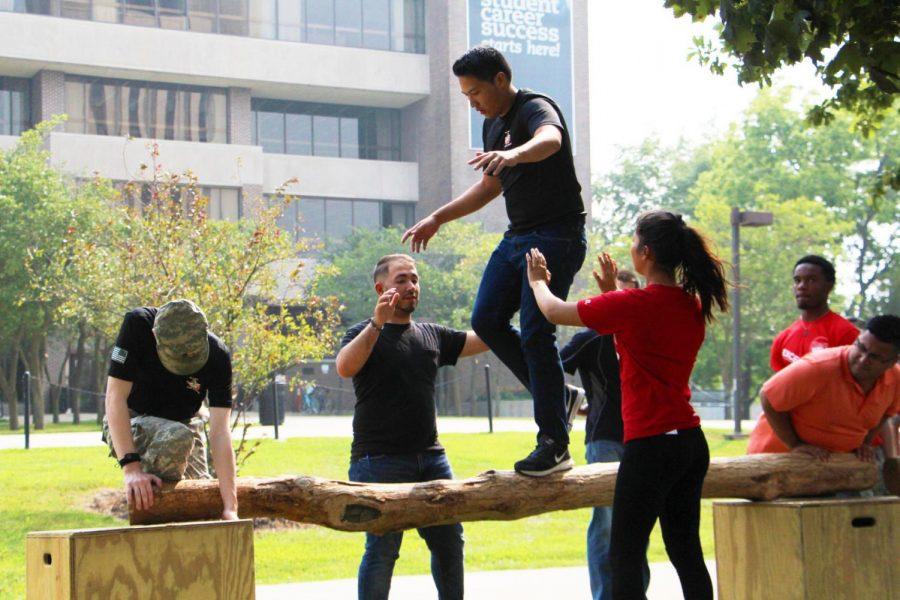ROTC hosts year’s first Leadership Lab
September 5, 2017
DeKALB — The ROTC held Operation Welcome Home Huskies, its first Leadership Lab of the year, Thursday, which tested cadets’ physical strengths and was designed to integrate new members into the program.
The fall semester’s recruits included 30 first-year cadets, called MSIs, and about 20 second-year cadets, called MSIIs — a decrease from last year. All cadets are referred to as MS, which stands for military science, and their year in the program.
During the summer, sophomores are given the opportunity to attend basic camp for leader training and juniors are required to participate in advanced camp. Major Kelly Strauf said many cadets spent the summer at some of the national camps, which meant no one was on campus to promote the program, contributing to its low enrollment.
Strauf said out of a class with 50 freshmen, only about 11 will stay in the program until they graduate.
“We need to build our freshmen class up,” Strauf said. “It’s a really tough job, and it’s something that people learn whether it’s for them or not throughout ROTC.”
Leadership labs, which are designed and run by MSIVs, are a requirement for cadets. In order to be eligible for waived tuition or room and board fees, members are only permitted one unexcused absence of the 15 leadership labs per semester.
Cadet Eddy Allen said MSIVs felt it was important to make changes to the labs to bring notoriety to the program.
“I think there’s a big lack of awareness about ROTC on campus here, unfortunately, and that’s another objective that we had with some of our labs was to get out outside of [Chick Evans Field House] because a lot of people don’t really know what we do — what we’re about — and there’s a lot of opportunities here that frankly people aren’t aware of,” Battalion Commander Ben Ziegler said.
At the start of the lab, the organization divided into two groups, first platoon and second platoon, which are subdivisions of cadets.
Each platoon consisted of four squads, one comprised of seniors, or MSIVs, and three comprised of underclassmen lead by juniors, or MSIIIs. Each squad had eight to nine members. Senior cadets worked the different stations and were responsible for timing and encouraging the squads.
“It’s a great way to test people’s abilities and be able to have them execute these events with the help from everybody else,” Strauf said.
Stations
Cadets were required to visit five stations for this lab, each of which were located in different areas across campus.
Strauf said the stations were designed to be fun, but this year they chose to include some things cadets experience while attending advanced camp training.
“For this particular lab we gave them maps of the campus and had them grate coordinates to each particular event,” Strauf said. “And they were expected to plot their points and then go to and from their different locations.”
One of the stations, the casualty carry, provided new recruits the opportunity to attempt an activity that may be of use in the field.
Near Lowden Hall the casualty carry station required cadets to load and carry a dummy on a medical stretcher. While carrying the stretcher, cadets ran out, rounded a cone and returned to their starting point. To succeed, squad members alternated and had to safely hand off the stretcher while keeping it steady.
At the one-rope bridge station, squad members had to strap into a harness and pull their bodies across the creek located in between Neptune West Residence Hall and Reavis Hall. The task challenged their upper body strength as they traversed on a rope that extended across the creek.
To the left of the field house was the GSA pull station where squad members rushed to put on gloves and position themselves staggered along a rope that was attached to a white van. Working together, each squad was able to pull the van several feet from its starting point across the finish line.
Between the Holmes Student Center and Founder’s Memorial Library was the log balance station. Two long logs were raised from the ground with two crates at each end. Cadets had to successfully make their way across the logs while a cadet on either side of them assured they would not fall.
Directly across from the casualty carry, on the other side of Castle Drive, two large tires were placed in the grass. Upon arriving at the station, two cadets at a time worked together to flip the tires 50 meters and back. By working in groups of two, cadets experienced what is similar to having a battle buddy in the army.
Winners
The winner of the event was selected based on who completed all the stations in the shortest amount of time after time deductions were factored in.
After completing a station, squads were asked to answer trivia questions related to the university or the program. Squads that provided the correct answer to the trivia question received a time deduction from their scores.
Winners were announced once each squad completed all stations. Second Platoon Second Squad were the victors, completing the lab with an end time of 55 min.
“This lab, especially, was extremely important to us because we’re trying to recruit more incoming cadets to meet a certain quota for officers since the army is growing, and the military in general is growing,” Strauf said.
The second leadership lab for the ROTC will focus on “Drill and Ceremony.” The event will be held 2 p.m. Thursday.







